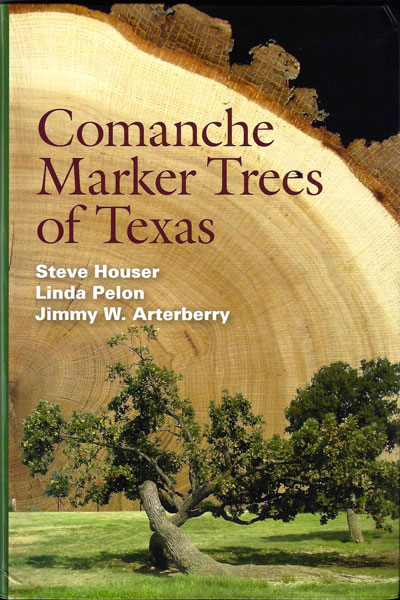Comanche Marker Trees of Texas

Steve Houser, one of our state’s finest arborists, has been working on a project of passion for many years now. Every time I’ve seen Steve in recent years, I’ve asked how the Marker Tree book was coming. And now it’s here!
This book is of historic proportions. The author team also includes Linda Pelon (professor of anthropology and history, McLennan Community College) and Jimmy Arterberry (Comanche Tribal Preservation Officer).
Rather than trying to do a book review on my own, I decided to turn to the best. Carolyn Skei edited my latest book, and she also did the first major edits on Comanche Marker Trees of Texas. I knew Carolyn would be the most capable person of all to give us a thumbnail. Here’s what she sent us this morning:
“Tree lovers and those fascinated by Texas history and Native American culture will find much of interest in a new book from Texas A&M University Press. Comanche Marker Trees of Texas, by Steve Houser, Linda Pelon and Jimmy W. Arterberry, introduces readers to the first six trees in Texas to be authenticated as Comanche marker trees. They are trees with histories dating to the time when the Comanche people roamed certain areas of the state – trees now firmly believed to have marked the way to low water crossings or a paint rock quarry, for example, or to have sheltered children and their elders for storytelling. A few readers will remember past news coverage of the Gateway Park marker tree or the California Crossing marker tree, two of the trees discussed, but in this book they will find in-depth explorations of the ways these natural and cultural treasures have been identified and recognized.
Pelon, an anthropologist, sets the stage with the historical record and her enthusiasm for our early landscape. Houser, a DFW arborist familiar to Sperry e-gardens readers, recounts the painstaking process of dating the trees and identifying the species and the forces that probably shaped them. (Some, but not all, were scored and bent as saplings to indicate direction along a trail.) Arterberry, a Comanche Nation tribal officer, illuminates for readers the many uses his nomadic people have made, and continue to make, of our native pecans, bur oaks, and countless other trees. The shared talents of these three authors have produced a really good read for anyone interested in preservation, cultural understanding, and the rich natural history and beauty of Texas.”
Carolyn Skei
Book can be purchased from:
tamupress.com
amazon.com
barnesandnoble.com
